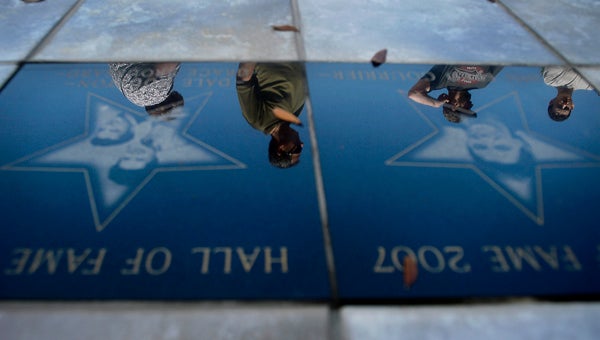Don’t fry your eyes when total eclipse day comes
Published 11:08 am Thursday, June 22, 2017
COLUMBIA — Looking directly at a solar eclipse without any eye protection is a really bad idea.
The exception on Aug. 21, though, will be those short couple of minutes when the eclipse reaches totality, the period when the moon completely covers the sun’s face and leaves only its corona visible. In Columbia, that will be from 1:12 p.m. to nearly 1:15 p.m.
The sun is an exploding ball of hydrogen and helium that can literally burn its image into the naked eye if one looks at it long enough. It’s so bright that prolonged exposure to the eye can have massive repercussions.
Angela Speck, director of astronomy at MU, is studying the upcoming eclipse and helping Columbia prepare for it.
“We should never look at the sun directly,” she said, adding that doing so is akin to someone with sensitive skin stepping out without sunscreen.
“On a sunny day when you’re not looking directly at the sun, but your skin is seeing it, your skin can get burned,” she said. “If you look directly at it, you will have some of those high-energy photons and UV rays going to the back of your eye and hitting the retina.”
Those ultraviolet rays can essentially cause an optical sunburn, but they’re not the only aspect of the sun that causes damage. Infrared light, Speck said, works differently. Whereas ultraviolet rays can cause visible burns, infrared rays can cause the eye to overheat.
“There are many things that can happen to the eye when directly looking at the sun,” said optician Josh Stanfast from Andrew Stone Optometry. “It is usually too painful to do so longer than two to three seconds, but if done longer can result in solar retinopathy, which can have short- and long-term effects as the retina tissue is oxidized by the UV.”
Short-term damage, Stanfast said, can range from dark spots and temporary blindness to headaches and blurry vision. Long-term damage, in extreme cases, can include cataracts and blindness.
Part of the risk of eye damage from the sun, Stanfast said, is that the retina has no pain receptors. Your eyes could be burning, but you would be unaware.
“Serious damage can be done in as little as 60 to 100 seconds,” he said.
Regular old sunglasses aren’t enough to protect our eyes from the sun, not even the ones that offer UV protection. Sunglasses, Speck said, are built to protect eyes from reflected sunlight, not direct sunlight.
“Not only are solar glasses intended to prevent any UV penetration to the eye, but they block the ultra-high intensity visible light,” Stanfast said, “allowing you to look directly at the sun without essentially burning your retinas.”
Eclipse shades, or solar glasses, block out so much light that wearing them for anything other than looking at the sun is like being blindfolded. Only the strongest light gets through them.
“Solar glasses are dramatically darker than sunglasses and are even darker than most welding shields to help put their level of protection in perspective,” Stanfast said. “Solar glasses even have special filters that sunglasses simply do not have. It would make them impossible to wear for anything other than viewing the sun.”
Eclipse watchers also should avoid looking at the sun through binoculars, telescopes or phone cameras. And the common notion that one can look at the sun through a glass of water or tea is false. Using reflective Mylar doesn’t work, either.
Even those with eclipse shades should avoid using telescopes or binoculars because their lenses will focus the sun’s rays like a magnifying glass and melt the shades. It is safe, however, to buy solar filters to put over binoculars.
It is also safe to use the naked eye to watch the eclipse during totality. The corona, like the rest of the sun, emits harmful ultraviolet, infrared and x-rays, but the Earth’s atmosphere dilutes the rays and makes the corona safe to observe, Speck said.
“It’s only as bright as the full moon,” she said. “So even though you’re still getting light in, it’s not with the (same) intensity.”
Normally, there’s no way to observe the corona without looking at the sun directly.
“The sun itself is a million times brighter than the corona,” Speck said. “With only a thousandth of the sun showing, that’s still a thousand times brighter than the corona on its own.”
Eclipse shades can be purchased from a variety of shops, including the Mizzou Store, for around $1.50. Solar filters for cameras and telescopes can be purchased locally at Creve Coeur Camera. Online, solar filters for binoculars run for around $20.
For a comprehensive guide to eclipse safety, check out NASA’s website and Mizzou’s official eclipse page. There’s good advice for people who want to make sure they can see the next solar eclipse in 2024.
Supervising editor is Scott Swafford.
Don’t fry your eyes when total eclipse day comes
Gabriela Velasquez
COLUMBIA — Looking directly at a solar eclipse without any eye protection is a really bad idea.
The exception on Aug. 21, though, will be those short couple of minutes when the eclipse reaches totality, the period when the moon completely covers the sun’s face and leaves only its corona visible. In Columbia, that will be from 1:12 p.m. to nearly 1:15 p.m.
The sun is an exploding ball of hydrogen and helium that can literally burn its image into the naked eye if one looks at it long enough. It’s so bright that prolonged exposure to the eye can have massive repercussions.
Angela Speck, director of astronomy at MU, is studying the upcoming eclipse and helping Columbia prepare for it.
“We should never look at the sun directly,” she said, adding that doing so is akin to someone with sensitive skin stepping out without sunscreen.
“On a sunny day when you’re not looking directly at the sun, but your skin is seeing it, your skin can get burned,” she said. “If you look directly at it, you will have some of those high-energy photons and UV rays going to the back of your eye and hitting the retina.”
Those ultraviolet rays can essentially cause an optical sunburn, but they’re not the only aspect of the sun that causes damage. Infrared light, Speck said, works differently. Whereas ultraviolet rays can cause visible burns, infrared rays can cause the eye to overheat.
“There are many things that can happen to the eye when directly looking at the sun,” said optician Josh Stanfast from Andrew Stone Optometry. “It is usually too painful to do so longer than two to three seconds, but if done longer can result in solar retinopathy, which can have short- and long-term effects as the retina tissue is oxidized by the UV.”
Short-term damage, Stanfast said, can range from dark spots and temporary blindness to headaches and blurry vision. Long-term damage, in extreme cases, can include cataracts and blindness.
Part of the risk of eye damage from the sun, Stanfast said, is that the retina has no pain receptors. Your eyes could be burning, but you would be unaware.
“Serious damage can be done in as little as 60 to 100 seconds,” he said.
Regular old sunglasses aren’t enough to protect our eyes from the sun, not even the ones that offer UV protection. Sunglasses, Speck said, are built to protect eyes from reflected sunlight, not direct sunlight.
“Not only are solar glasses intended to prevent any UV penetration to the eye, but they block the ultra-high intensity visible light,” Stanfast said, “allowing you to look directly at the sun without essentially burning your retinas.”
Eclipse shades, or solar glasses, block out so much light that wearing them for anything other than looking at the sun is like being blindfolded. Only the strongest light gets through them.
“Solar glasses are dramatically darker than sunglasses and are even darker than most welding shields to help put their level of protection in perspective,” Stanfast said. “Solar glasses even have special filters that sunglasses simply do not have. It would make them impossible to wear for anything other than viewing the sun.”
Eclipse watchers also should avoid looking at the sun through binoculars, telescopes or phone cameras. And the common notion that one can look at the sun through a glass of water or tea is false. Using reflective Mylar doesn’t work, either.
Even those with eclipse shades should avoid using telescopes or binoculars because their lenses will focus the sun’s rays like a magnifying glass and melt the shades. It is safe, however, to buy solar filters to put over binoculars.
It is also safe to use the naked eye to watch the eclipse during totality. The corona, like the rest of the sun, emits harmful ultraviolet, infrared and x-rays, but the Earth’s atmosphere dilutes the rays and makes the corona safe to observe, Speck said.
“It’s only as bright as the full moon,” she said. “So even though you’re still getting light in, it’s not with the (same) intensity.”
Normally, there’s no way to observe the corona without looking at the sun directly.
“The sun itself is a million times brighter than the corona,” Speck said. “With only a thousandth of the sun showing, that’s still a thousand times brighter than the corona on its own.”
Eclipse shades can be purchased from a variety of shops, including the Mizzou Store, for around $1.50. Solar filters for cameras and telescopes can be purchased locally at Creve Coeur Camera. Online, solar filters for binoculars run for around $20.
For a comprehensive guide to eclipse safety, check out NASA’s website and Mizzou’s official eclipse page. There’s good advice for people who want to make sure they can see the next solar eclipse in 2024.
Supervising editor is Scott Swafford.






